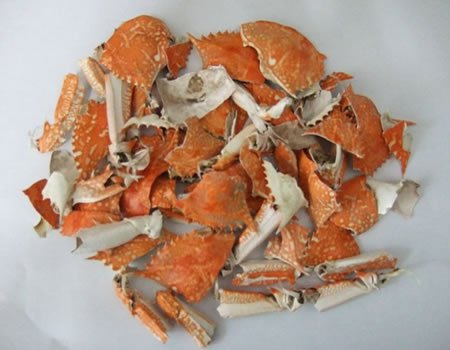Crab shell, green solution to malaria, heart attacks?
 noparticles may curb the spread of malaria-carrying mosquitoes, said scientists who tested the environment friendly solution successfully in India.
noparticles may curb the spread of malaria-carrying mosquitoes, said scientists who tested the environment friendly solution successfully in India.
Chinese researchers, who developed this spray believed that the solution can be employed at low dosages to strongly reduce populations of the malaria vector, the Anopheles sundaicus mosquito without detrimental effects on the predation of natural mosquito enemies, such as goldfishes.
Mosquitoes carry diseases such as malaria, dengue fever, yellow fever, the Zika virus and encephalitis. Despite the many years of research on the subject, malaria remains a global health problem, especially in Sub-Saharan Africa and Asia.
According to the World Health Organisation, one child dies every minute from malaria in Africa. Products such as organophosphates, insect growth regulators and microbial control agents and organic solutions are used in efforts to control mosquito populations and the spread of the disease, but the mosquitoes just won’t quit.
The researchers were seeking a new solution to this problem, so the team at the National Taiwan Ocean University turned to chitosan or chitin.
In its preparation, the researchers took chitosan or chitin, a non-toxic natural substance that has been used in wound healing and in manufacturing biodegradable food package coating.
Chitin is found in animal tissues, such as the exoskeletons of arthropods, bird beaks and insect eggs. It can easily be chemically changed, is quite strong and, because of its abundance in nature, it is cost-effective to use.
Researchers first crushed and oven-dried the exoskeletons of a number of crabs before extracting chitin and other minerals.
The subsequent creamy-white filtrate was then mixed with silver nitrate to obtain a brown-yellow solution of silver nanoparticles.
When the solution was sprayed over six water reservoirs at the National Institute of Communicable Disease Centre in Coimbatore, they found that even in small concentrates it killed mosquito larvae and pupa quite effectively.
The solution was also tested in conjunction with freshwater goldfish that fed on mosquito larvae.
The nanoparticle solution did not have any effect on the fish, indicating that it is an environmentally friendly and non-toxic product.
Also, the researchers said that it also inhibited the growth of disease-causing bacterial species such as Bacillus subtilis, Escherichia coli, Klebsiella pneumoniae and Proteus vulgaris in the study published in the journal, Hydrobiologia.
Traditional medicine in Asia and elsewhere frequently uses marine animals, including dried sponges, corals and jellyfish, shells of crabs, oysters, conch and other mollusks, pearls and cuttlefish ‘bones’, sea cucumbers, sea horses and many other marine animals to prepare powders, ointments and decoctions for many ailments.
Their efficacy and method of action often not described even if treatments work as intended are just being tested with western scientific methods.
In 2014, researchers at Florida Atlantic University and their colleagues developed an oral form of microparticles in crab and other crustacean shells as a dietary supplement that may prevent and treat IBD and other inflammatory diseases like Crohn’s and ulcerative colitis.
Current medications for IBD include antibiotics, corticosteroids and other biologic anti-inflammatory drugs that are costly and don’t always work.
Chitin microparticles are also non-toxic, biodegradable and non-allergenic, and therefore safe for oral ingestion as a dietary food supplement.
Chitin microparticles have also been used to treat seasonal allergies in humans.
Many scientists now believe that most—or perhaps all—chronic diseases stem from chronic inflammation, which plays a direct role in diseases such as IBD, diabetes, cardiovascular disease, cancer, asthma and many other diseases.
The researchers demonstrated that oral administration of chitin microparticles reduces disease conditions of allergic asthma, food allergies, colitis and food borne infections in animal models and seasonal allergies in humans.
They have also conducted additional studies to advance their understanding of the mechanisms underlying the effects of chitin microparticles on macrophage activation.
Nearly 50 years ago, scientists discovered the horseshoe crab’s clotting-response to bacterial toxins. Now, its blood is harvested in huge quantities, to be used in a test to ensure medical products are not contaminated.
Limulus amebocyte lysate (LAL), a reagent which is extracted from the horseshoe crab’s blue blood, can detect just one picogram of harmful bacterial endotoxin per milliliter — equivalent to one grain of sand in an Olympic-size pool.
The U.S. Food and Drug Administration (FDA) requires that intravenous drugs and any medical equipment coming in contact with the body must first pass through the crab’s blood, from needles to surgical implants including pacemakers.
Moreover, researchers also reported a chemical found in a crab’s shell could help save lives after a heart attack by bridging the gap in the heart’s electrical signals.
The electrically-conductive patch is made from a film of chitosan, a chemical found in crab shells that is often used as a food additive; polyaniline, a conductive material; and phytic acid, a substance found in plants, which is added to the polyaniline to switch it to its conducting state.

Met can I tell you that mi nuh eat crab because dem a scavengers? The disgusting things that crabs eat yuck!Same way I watched a video of a pig eating a dog smh.Certain defilements mi can do without!
Fish is scavenger too I’m straight vegan for years but it takes a lot of discipline!